It was last week when I heard about the City Palace Jaipur guided walking tour with museum curators. I mulled over the possibility of joining this walk but, there was one problem; it was to take place during office hours. After much thinking, I decided to skip work for a few hours to join an informative guided walking tour of City Palace Jaipur.
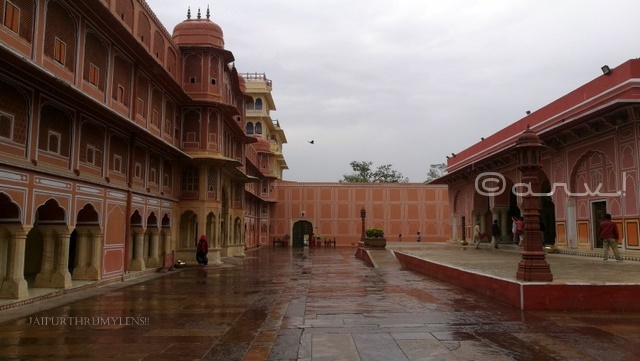
A Guide To The City Palace Jaipur With A Walking Tour
It was Wednesday morning in March with an overcast sky when I reached City Palace Jaipur entry gate 1 & inquired about the City Palace Jaipur guided walking tour. The palace office possessed no information about the same and directed me to Gate no. 2 which is the main entrance near Baradari restaurant.
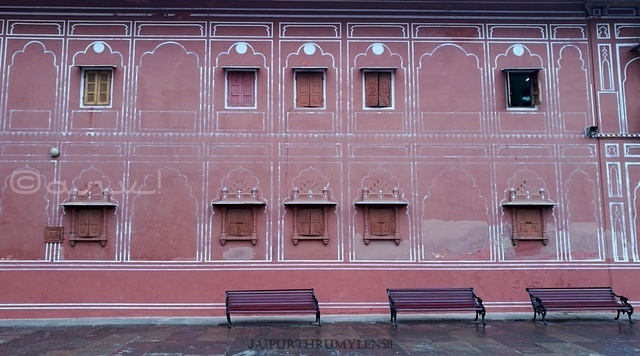
On inquiring about the walk at the ticket window I was suggested to buy a City Palace Jaipur entrance ticket and proceed towards the coffee shop near the entrance of Sarvato Bhadra Chowk.
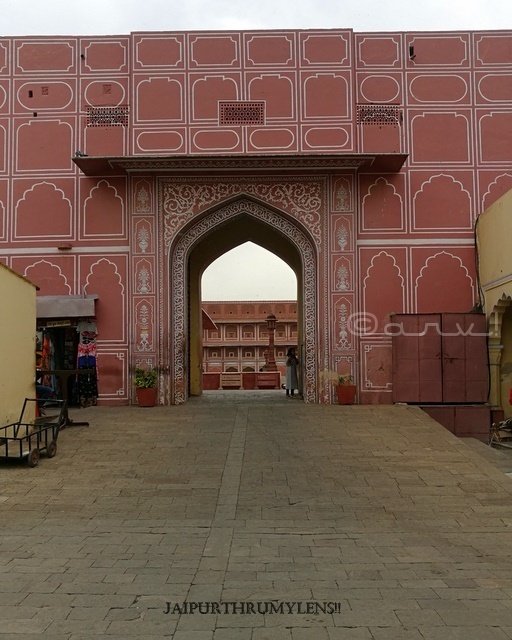
The curators of the Jaipur City Palace museum, two affable sassy ladies introduced themselves – Aparna Andhare and Sania and greeted everyone. They arranged it to celebrate the women’s day week with this event. The walk aimed at highlighting the importance of women in Jaipur court; Select people possessing a keen interest in heritage and art attended it.
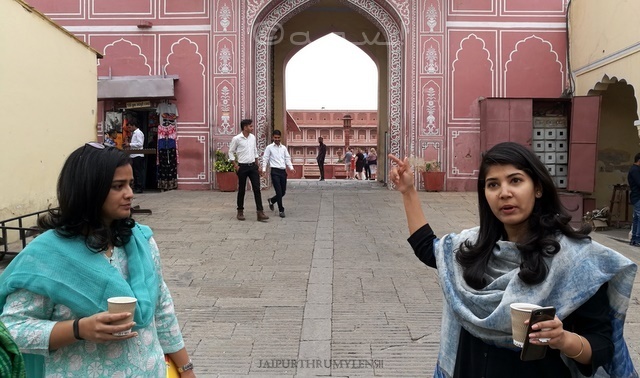
Sabha Niwas
Aparna Andhare led the City Palace Jaipur walking tour, and it started with a visit to Sabha Niwas, a hall equivalent to Diwan-e-Aam in Amer where the king would meet officials and the public. Diwan-e-Aam is an emulation of the Mughal court and shows Mughal influence in the Jaipur court.
Sabha Niwas is a spacious hall having paintings and photographs of the Jaipur rulers on its walls. This is where many prestigious ceremonies and events took place graced by eminent personas of its time. Aparna urged the attendees to undertake a brief tour of the hall and figure out if they could observe women in any pictures or paintings. It turned out that one can spot women only in the paintings as a muse.
Aparna suggested an intriguing book in this context that highlighted the life of royal women – Polygamy and Purdah women and society among Rajputs by Varsha Joshi. Also, worth mentioning here is that there were tussles for power among queens. The rules regarding accessions and lineage were ambiguous and led to confusion, schemes, plots, and wars.
After a quick tour of the Sabha Niwas, we moved to the Sarvato Bhadra.
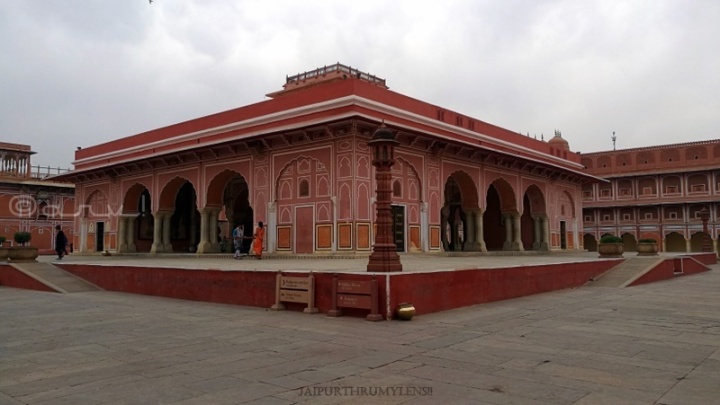
Sarvatobhadra Chowk
Sarvatobhadra is an equivalent of Diwan-e-Khas in Amer Fort, meant as a meeting place for a chosen few. This place is legendary for the display of two huge silver urns used by Maharajah Sawai Madho Singh II during his tour of England in 1902 on the occasion of the Coronation of King Edward VII. He carried the holy water of the river Ganges in these urns to last him for the two-month journey.
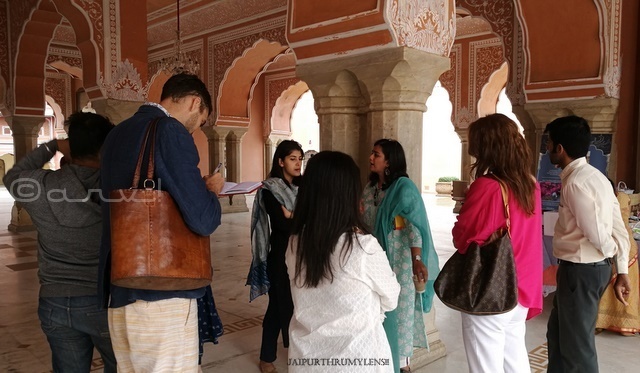
The talk continued about the life of women in royal courts. In most Rajput principalities women lived behind Purdah or curtain. They never made public appearances & observed public processions and events on the street behind lattices. They built Hawa Mahal to let royal women witness street & public processions behind the lattices. The Purdah system added an element of mysticism and suspense to the royal women.
Read The architectural marvel called Hawa Mahal
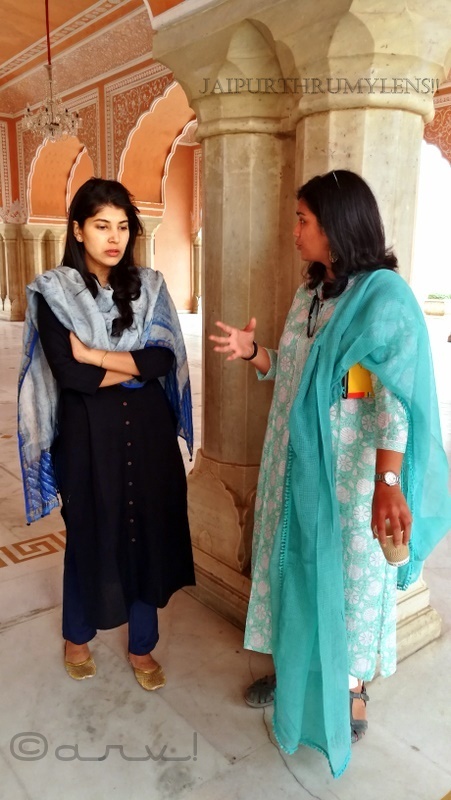
A remarkable but esoteric fact is that the royal women conducted the affairs of Jaipur for years acting as regent queen (for juvenile king). Historians mark the period before Maharajah Sawai Ram Singh II with conspiracies and plots schemed by the royal ladies. The women lived in a separate enclave inside the Jaipur City Palace called Zenana Deori. The most well-known name is Sisodia Rani who hailed from the Sisodia clan of Mewar.
Four Gates of Jaipur City Palace
The Pritam Niwas represent the most iconic section of Jaipur City Palace; pictures of the four City Palace gates are a massive hit on Instagram. It figures in the top places for Instagram-worthy photos in Jaipur.
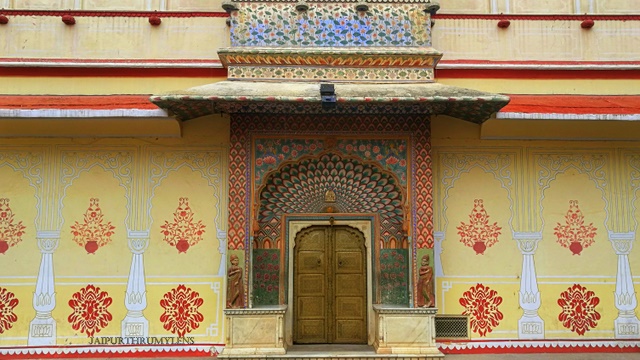
These four City Palace Jaipur doors represent four distinct seasons. The peacock gate represents autumn, the Lotus gate summer, the Green Leheriya gate spring, and the rose gate winter.
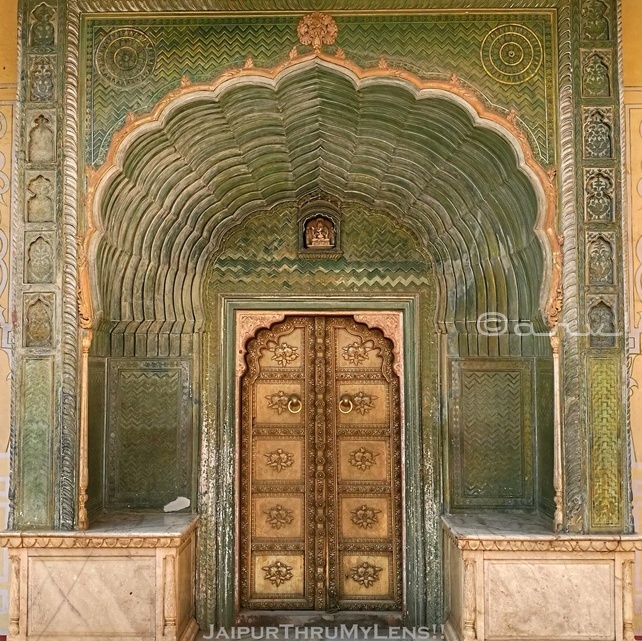
It doesn’t stop here; the gates also represent gods and goddesses – Lord Vishnu, Shiv-Parvati, Lord Ganesha, and Goddess Devi respectively.

Unlike today, Pritam Chowk was not accessible to everyone in the past. It overlooks the Pritam Mahal which remains a residential area of the royal family to date. As soon as we reached Pritam Chowk it started drizzling.
Read 5 most Instagram-worthy places in Jaipur
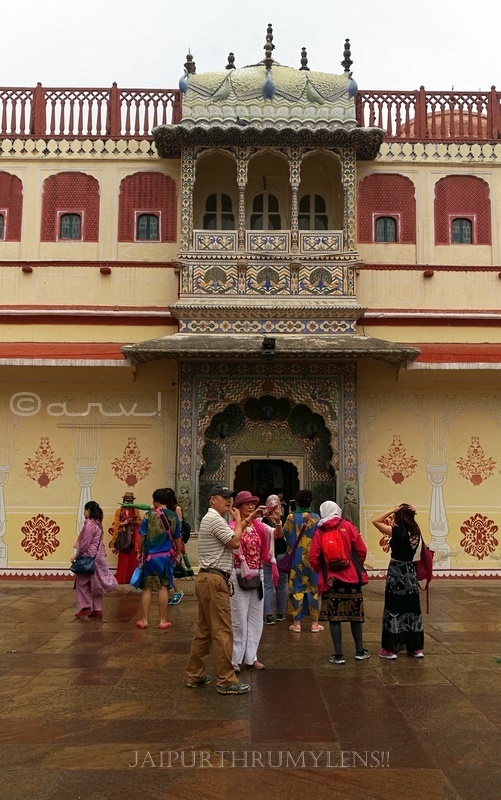
The discussion here turned toward the life of women in Zenana Deori. Deori remains a world of its own. Two significant processions start and end in Zenana Deori – Teej, and Gangaur. It is a time-honored tradition that still has continued to date. Zenana Deodi is off-limits for everyone because of judicial issues about its ownership.
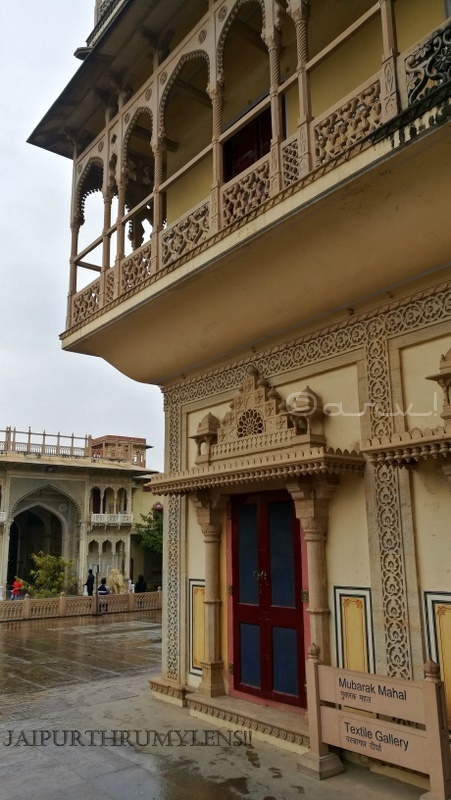
Mubarak Mahal
Maharajah Sawai Madho Singh II constructed the Mubarak Mahal to receive dignitaries. The inputs of Samuel Swinton Jacob who built the Albert Hall Museum are clear from the fusion architectural style of the building. One of the most remarkable features of this building is the intricate marble Jali work. While they constructed it to welcome the state guests, today it houses a textile gallery. Its display includes dresses assumed by the kings and queens.
Aparana Andhare escorted us to a display comprising an intricate & opulent dress worn by a queen on the occasion of Diwali. Each color had its own significance like green Lehariya signified monsoon. Another unusual thing on display was a special metal ball used by the royal ladies during night polo matches. Why night polo matches? The logic provided was that women were under purdah and played polo only during the night. There is a long history of Chovgan being played in this region. Chovgan is an ancient polo game that owes its origin in Persia. It likely gained entry with the Mughals. Jaipur has its first Chovgan ground called Chogan Stadium. Many people claim that modern polo first appeared in Jaipur during the late 19th century; we know for sure that Chovgan was one of the favorite sports of Jaipur royalty.
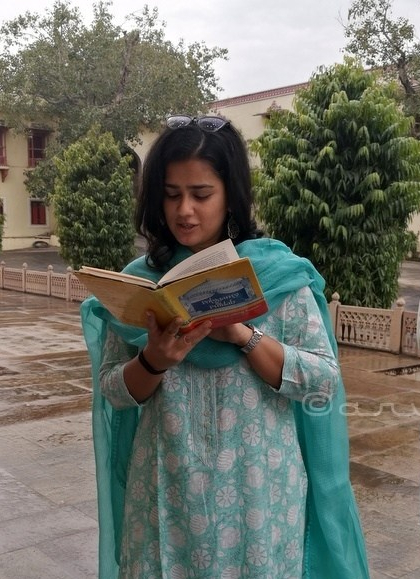
As soon as we stepped out of Mubarak Mahal, Aparna suggested we all should visit the Arms and Armory Museum once the walk was over. She mentioned they trained Rajput women in warfare techniques. Even now many Rajput women carry a small dagger, a customary practice, though. She read out a passage from the book to validate this claim. As far as I know, women from the Jaipur court never took part in wars and battles. The solitary instances of battles were for power between Maharajah Sawai Ishwari Singh and his brother Maharajah Sawai Madho Singh I. Marathas fought from the latter side. Technically, all these battles took place in far-off places but never in Jaipur.
The discussion turned to the difference between the Rajput practice of Sati and Jauhar. There is innumerable mention of Jauhar in history books. The Sati practice involved a widow throwing herself onto her husband’s funeral pyre and ending her life. Jauhar is an act of self-immolation by women to avoid being captured by the opposing army during a defeat. They did this to avoid enslavement and rape which were too common in those days. The Sati practice continued for years despite being banned in 1846 in Jaipur. It was in the 1980s when the Sati incident of Roop Kanwar in Sikar brought it back into the limelight. Government and women social activists launched an active campaign to banish it completely. Thankfully, this practice doesn’t exist anymore.
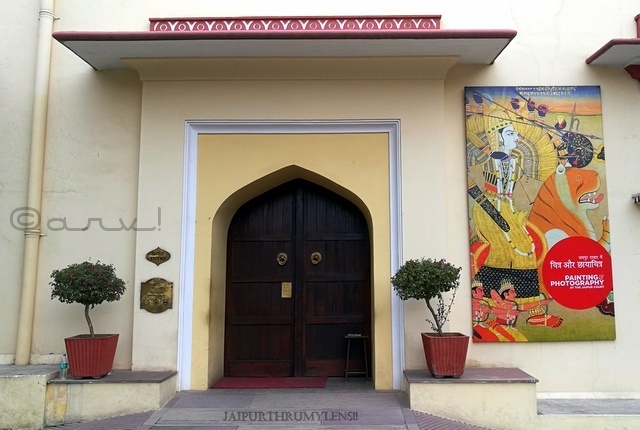
Painting and Photography Museum in City Palace Jaipur
From Mubarak Mahal, we walked to the most recent addition of museums in Jaipur City Palace, the Painting and Photography Museum. It contains many rare paintings, maps, layouts, books, and pictures. I enthusiastically recommend it to art lovers.
One of the most unusual items on display is an enlarged map of Surat City dating to 1700 AD. It will be hard to mention all the discussions about the art on display in this blog post.
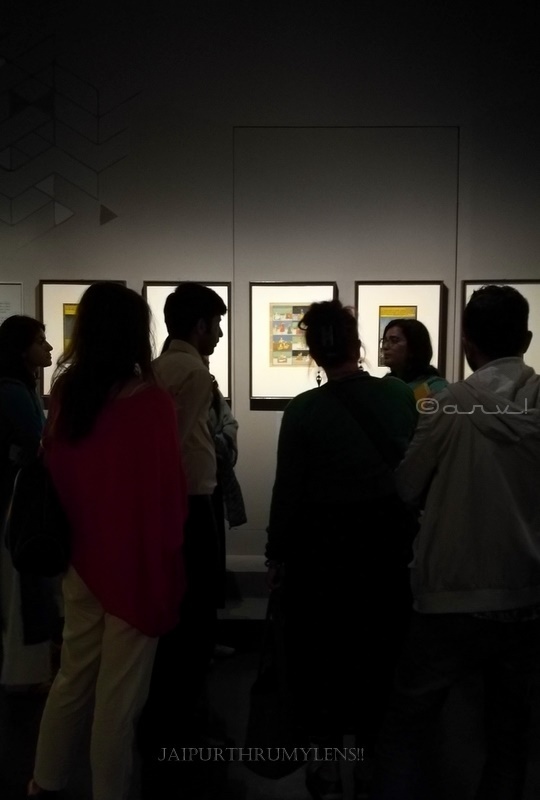
Another fascinating gallery in this museum is pictures clicked by Maharajah Sawai Ram Singh II. There are many old portraits of women, royal guests, nobles, and Jaipur city. It is worth mentioning his photographic equipment is on display. While today we can click excellent pictures with our smartphones, the equipment used in the 1850-60s was bulky and complicated. Developing prints was time-consuming, laborious, and expensive; only the wealthy could afford the hobby of photography.
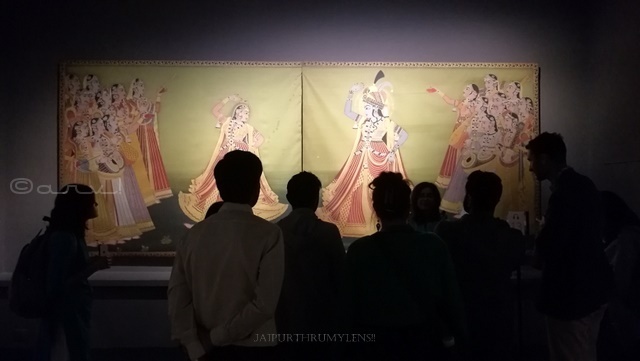
The City Palace Jaipur walking tour culminated in a gift shop near the painting and photography museum. Was it worth it? It sparked many new & fascinating discussions. It provides alternative perspectives and dimensions; it was definitely fruitful for the first-timers. The City Palace Jaipur Museum curator’s walk is not available commercially. However, you can hire a trained guide in Jaipur city palace. Mr. Sunil, a guide at Jaipur City Palace accompanied us to provide more input during the walk.
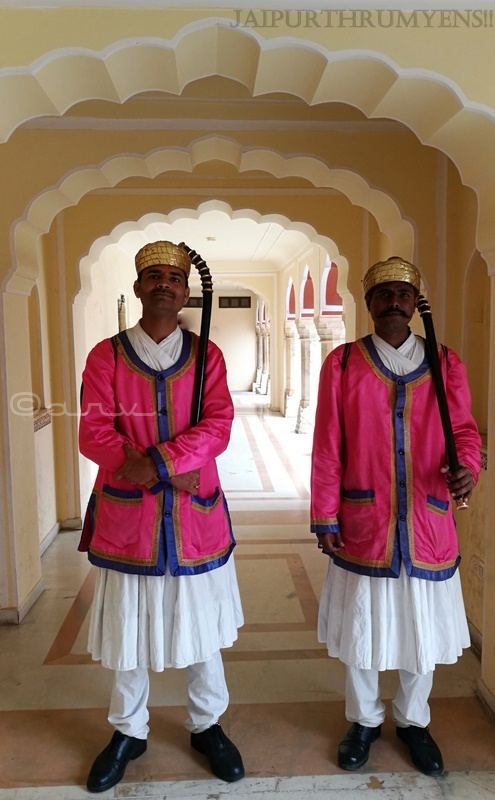
City Palace Jaipur Information
Timing
9 AM to 5 PM
Entry Fee
Rs 200 for Indian travelers. Rs 500 for foreign travelers
City Palace Jaipur History
The City Palace in Jaipur was built by Maharaja Sawai Jai Singh II around the same time when Jaipur city was founded. The history as per records suggests Jaipur City Palace was built between 1727 AD to 1732 AD in stages. It started with the building of the outer periphery and walls. As with many other royal abodes like Udaipur City Palace, successive generations kept adding buildings when required. The layout of Jaipur followed the ancient science of Shilpshastra and Vaastu Shastra. Jaipur City Palace has been placed in the center of the plan suggesting it is a nucleus. Among the rulers who have contributed significantly to the history of City Palace apart from Maharajah Sawai Jai Singh II are Maharajah Sawai Pratap Singh, Maharajah Sawai Ram Singh II, and Maharajah Sawai Madho Singh II. Maharajah Sawai Man Singh II, the last ruler of Jaipur started staying in Ram Bagh Palace instead of Jaipur City Palace.
What To See In City Palace Jaipur?
- Sabha Niwas
(already featured in this walk)
- Mubarak Mahal-Textile Museum
(already featured in this walk)

A clock tower can be found in the northeast corner of his large courtyard.
- Sarvatobhadra Chowk
(already featured in this walk)
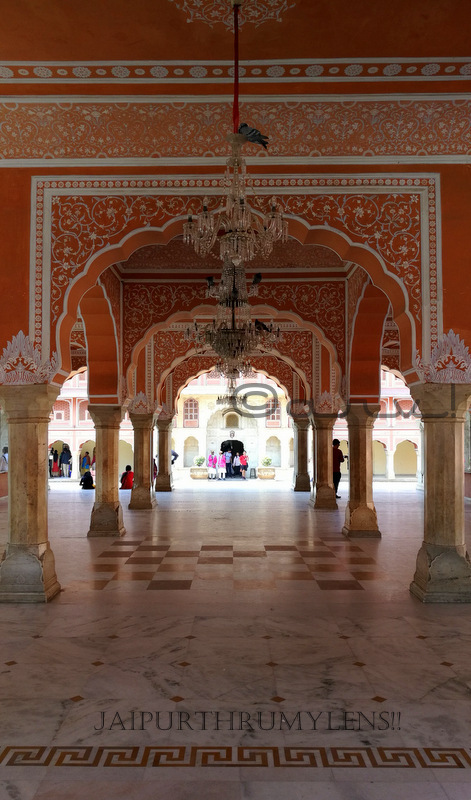
- Riddhi Siddhi Pol
Riddhi Siddhi Pol connects Pritam Chowk with Sarvato Bhadra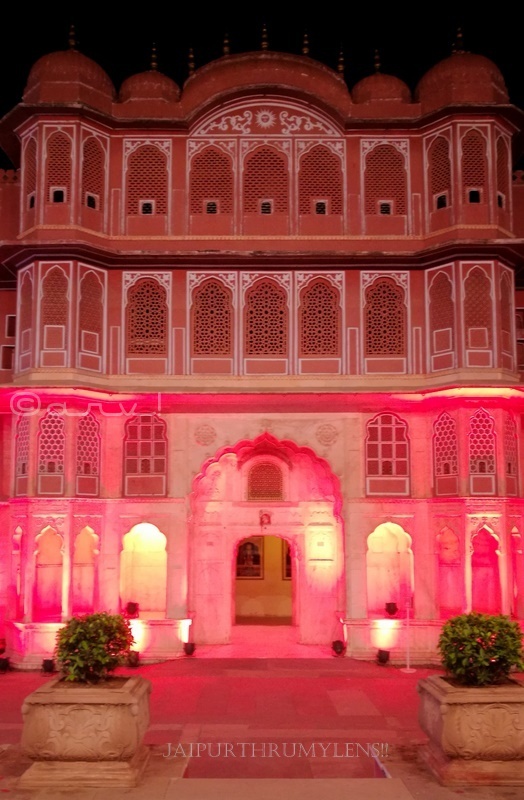
- Pritam Chowk
Pritam Chowk is where you will find the four doors of City Palace Jaipur featured earlier in this blog.
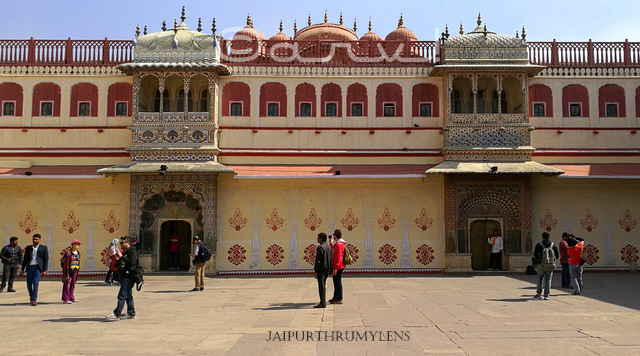
- Rajendra Pol
Maharajah Sawai Madho Singh II built Rajendra Pol along with the Mubarak Mahal which explains the similarity in architectural styles and themes of both structures. Rajendra Pol connects the Mubarak Mahal with Sarvato Bhadra.
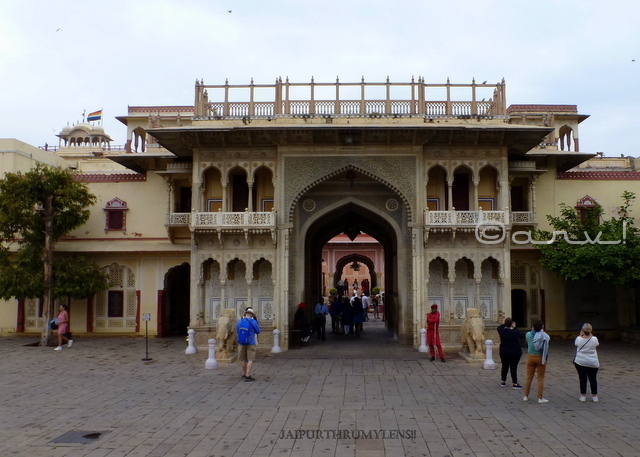
- Arms & Armoury Museum / Sileh Khana
This museum is in the northwest corner of the Mubarak Mahal square. There are many interesting arms and weapons on display in this museum used by the erstwhile rulers of Jaipur.
- Private rooms of Pritam Niwas
A special ticket of Rs 2000 will secure access to some iconic rooms and quarters of City Palace Jaipur. One of the most famous is The Blue Room, a big hit on Instagram.
- Painting and Photography Museum
(already featured in this walk) 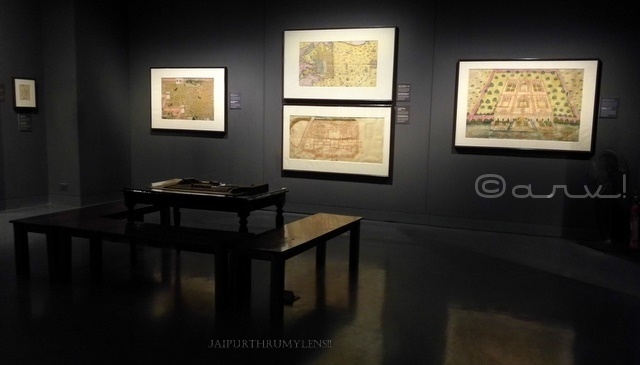
- Souvenir Shopping at Jaipur City Palace
The souvenir shop of City Palace is near the exit of the Painting and Photography Museum. If you are a shopaholic, there are plenty of things to buy i.e. paintings, garments, and books to name a few.
- Buggi Ride
An old horse carriage called Buggi is available for travelers to take home the experience of yesteryears. You can hire a ride near the Mubarak Mahal.
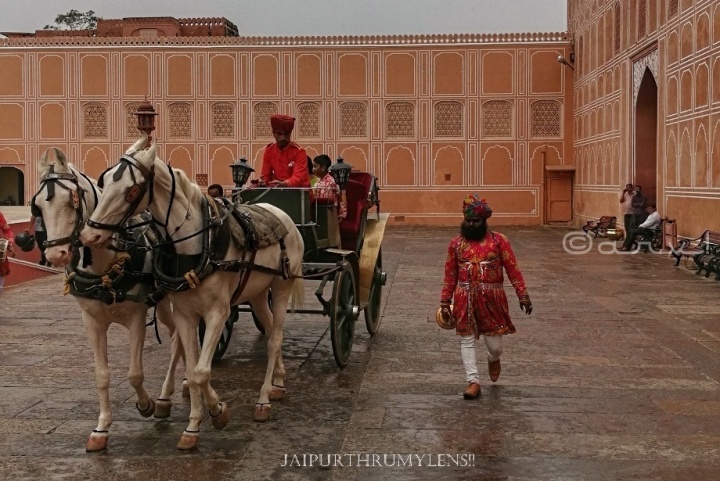
- City Palace Jaipur Restaurant – Baradari
Baradari is a good choice for those seeking to unwind over food and drinks in the walled city as there is no other good option apart from The Johri. Personally, I feel its interiors don’t go too well with the traditional Rajput architecture. The renovation emulates old European architecture with raw stone walls. Most travelers enjoy a pit stop at Baradari, though.
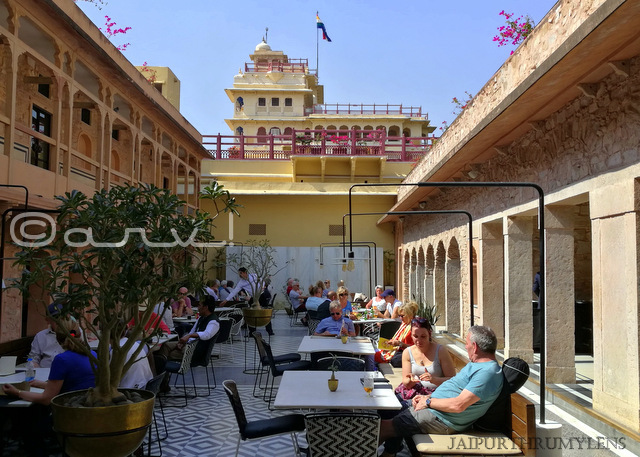
Things To Do And Place To Visit Near City Palace Jaipur
Nakkarkhana Darwaja or Naqqar Khana Gate
Nakkarkhana Darwaja or Naqqarkhana Gate is one of the first ones to encounter when entering through Sirehdyodi Bazaar near Hawa Mahal. Naqqar refers to drums. Musicians used this gate to announce the king’s arrival by playing the relevant instruments (as per occasion). These days it is just another gate.
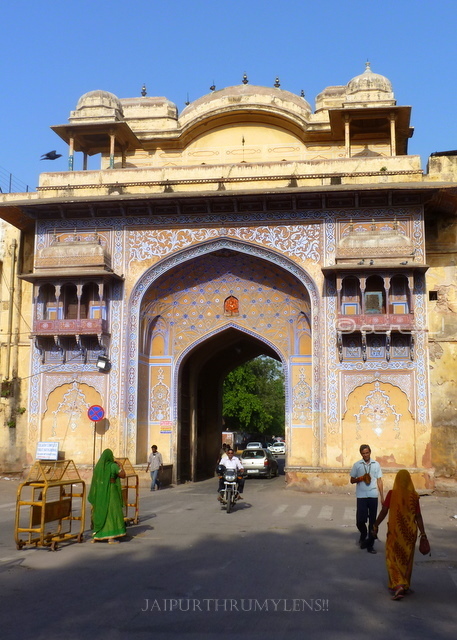
Jaleb Chowk
Jaleb Chowk is a large public square. In the past, the rooms lining the walls performed the function of a secretariat. Post-Indian Independence, the government took over the entire area. They used it for many government departments till they shifted them all to new buildings. These days the entire area is unkempt and has fallen into disrepair. It only serves as unregulated parking.
Govind Dev Ji Temple
Govind Dev Ji temple is worth visiting to experience the atmosphere. Maharajah Sawai Jai Singh II found this temple at the same time as Jaipur city. The idol of Govind Dev Ji was originally in the Govind Dev Ji temple of Vrindavan but shifted to Jaipur in the late 17th century to save it from the destruction ordered by Mughal ruler, Aurangzeb. Read the complete post on Govind Dev Ji Temple Devotees at Govind Dev Ji Temple
Jantar Mantar
Jantar Mantar is a solar observatory in the City Palace complex and worth visiting. The solar instruments made from metal and masonry structures are as precise as modern instruments and still functional. It is a UNESCO World Heritage Site. Jantar Mantar entrance is near City Palace entry gate no 1.

Hawa Mahal
Hawa Mahal needs no introduction. It is as iconic as the Eiffel Tower and the Taj Mahal. Most travelers only witness the facade on the street but there are lots to discover and experience by taking a tour inside the Hawa Mahal complex. I did and you can read more about it here The architectural marvel – Hawa Mahal. City Palace to Hawa Mahal is a walking distance.
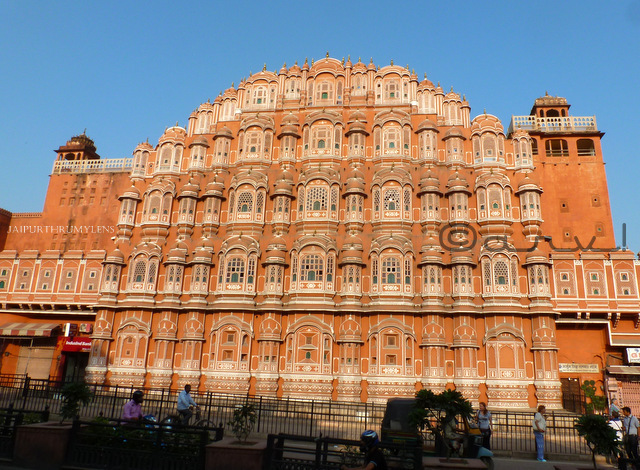
Isarlat Sargasuli
The Isarlat is a seven-story victory tower in Tripolia Bazaar. It is worth visiting for the great views of old Jaipur city. It is also called Sarga Suli.
Sargasuli history-Isarlat was built by Sawai Ishwari Singh to commemorate a win against wars fought with Marathas and his brother Sawai Madho Singh II. This building is part of the composite ticket issued by the Department of Archaeology which includes the Amer Fort and Albert Hall Museum. 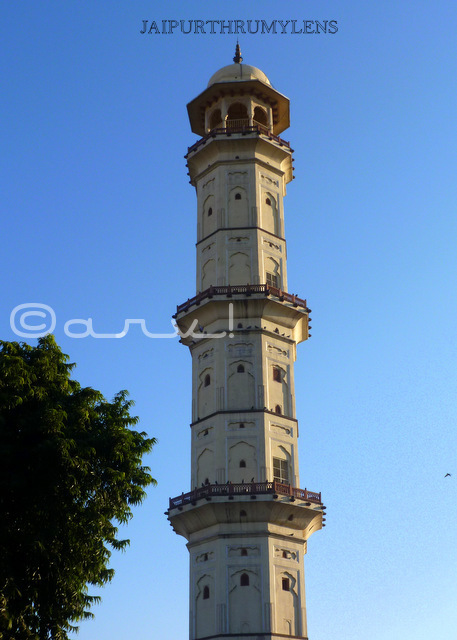
Heritage Temples of Jaipur
Jaipur has many heritage temples, Jaipur Court commissioned and built many of these. Although it is difficult to cover them all, some are worth visiting.

Check out Ramchandra Temple, Brij Nidhi Temple, Galta Ji Temple, and Radha Madhav Temple at Kanak Vrindavan to name a few.
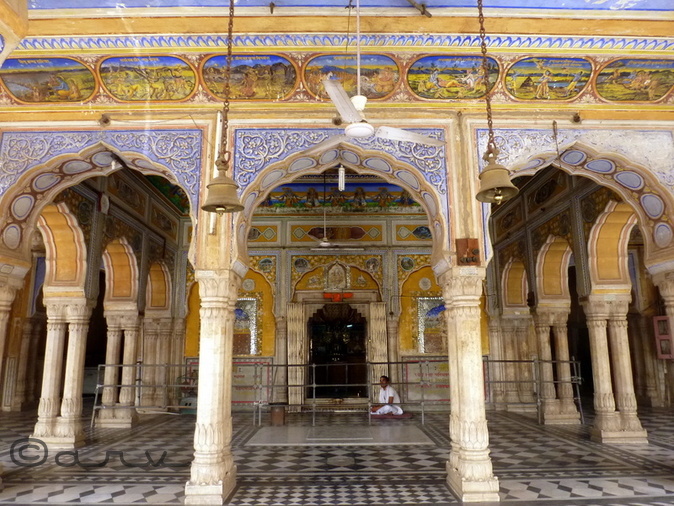
Heritage Walk in Jaipur
A heritage walking tour in old Jaipur is worth experiencing to uncover its true essence. Although many operators are offering such heritage walks in Jaipur, many of them rely on cooked-up stories rather than facts and this is true even for some known names. Read more about Heritage walk in Jaipur | Walking tour in the old walled city

Additional Information About City Palace Jaipur
City Palace Jaipur Wedding Venues
The City Palace Jaipur is one of the most sought-after places in Jaipur among destination weddings in Rajasthan. The regal setting of the City Palace is a big draw for NRI destination weddings. This is why many wedding planners in Jaipur recommend the City Palace for HNI clients. It is one of the most expensive wedding venues in Jaipur ranked just after the Rambagh Palace and the Raj Palace. The receptions with small gatherings are commonly organized in the courtyards of the Jaipur City Palace -Sarvato Bhadra Chowk and Pritam Niwas Chowk; ideal for 500-900 people.
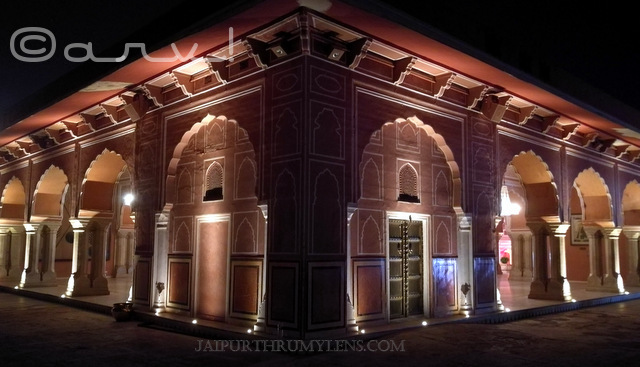
For bigger ones, there are lawns just behind the Chandra Mahal – Jai Niwas Lawns. This City Palace Jaipur wedding venue can easily accommodate a few thousand guests.
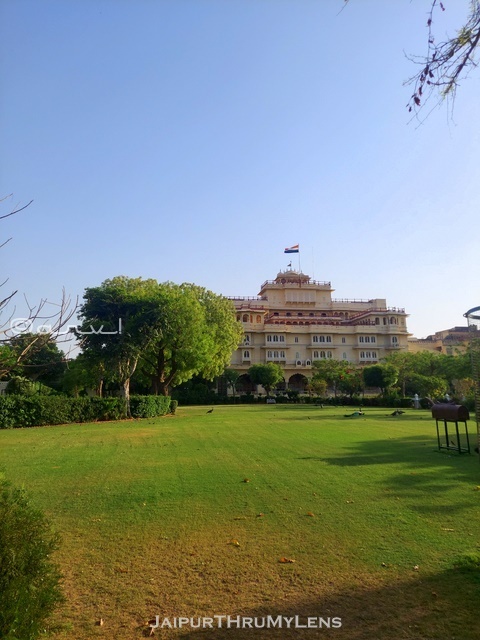
How much does it cost to get married in City Palace Jaipur? Well, a couple of Lakh. The cost keeps varying; you can check for the cost of the Jaipur City Palace wedding venue with their office.

City Palace Light And Sound Show
City Palace light and sound show called SCULPTURE LUMIÈRE SHOW is held at 7.30 PM every day. The ticket is priced at Rs 250 for Indians and Rs 500 for foreigners. You can also combine a museum visit with the City Palace Light and Sound show and save money. Plan your visit around 6.30 PM, the ticket costs Rs 300 for Indians.
Is City Palace Jaipur Worth Visiting?
The City Palace Jaipur is one of the top places to visit in Jaipur. Lately, Jaipur City Palace has become one of the most sought-after places among the Instagrammers. A reason why it is rated high among the Insta-worthy places in Jaipur. The City Palace interiors of a few rooms of Chandra Mahal accessible with a premium entry ticket are worth the price if you want Instagram-worthy pictures. Otherwise, you might find the premium ticket a waste of money. As for the regular entry tickets priced at Rs 250 for Indians, it is slightly expensive compared to other tourist attractions managed by the Department of Archaeology like Nahargarh Fort, Amer Fort, Hawa Mahal, or Albert Hall Museum. If you are seeking a visit to other museums then you might check out the Anokhi Museum, Albert Hall Museum, or Museum of Legacies. All these are priced significantly cheaper. On a positive note, City Palace in Jaipur is worth a visit as it can be easily covered even if you have limited time because it is located in the heart of the city close to Johari Bazaar, a great place for shopping in Jaipur.
If you enjoyed reading this post, don’t forget to share it on your social media.
Follow me on Facebook Twitter Instagram

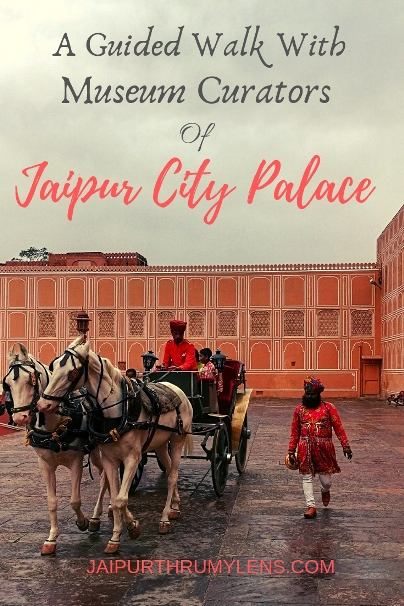
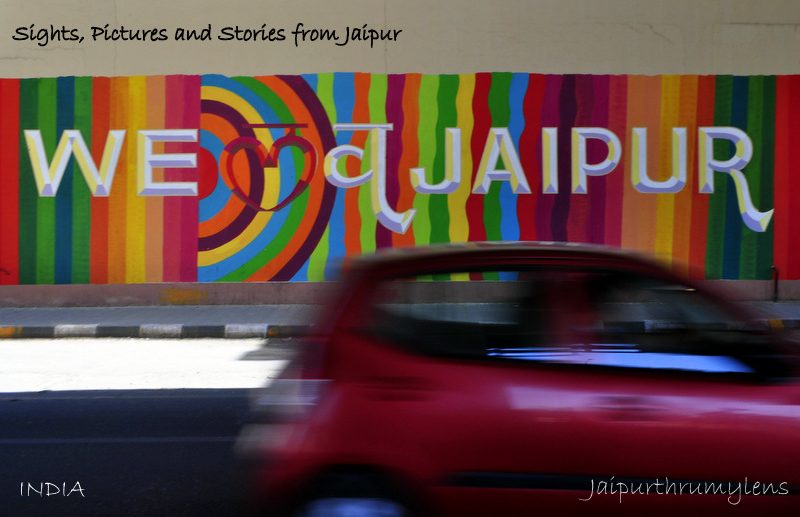
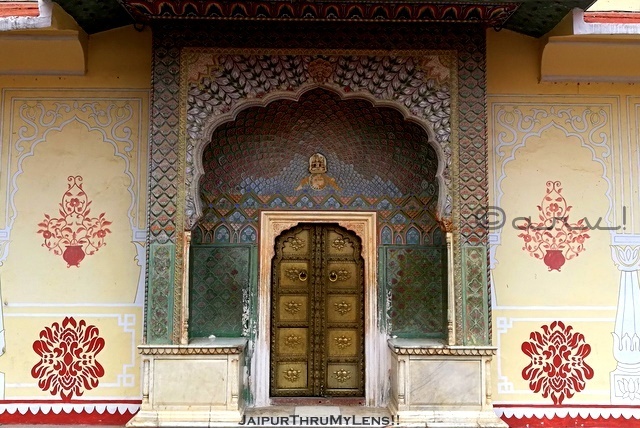




142 thoughts on “City Palace Jaipur | A Walk With Museum Curators”